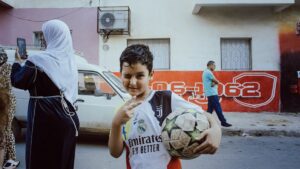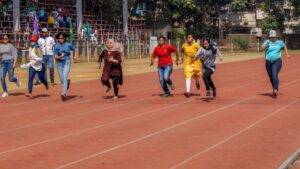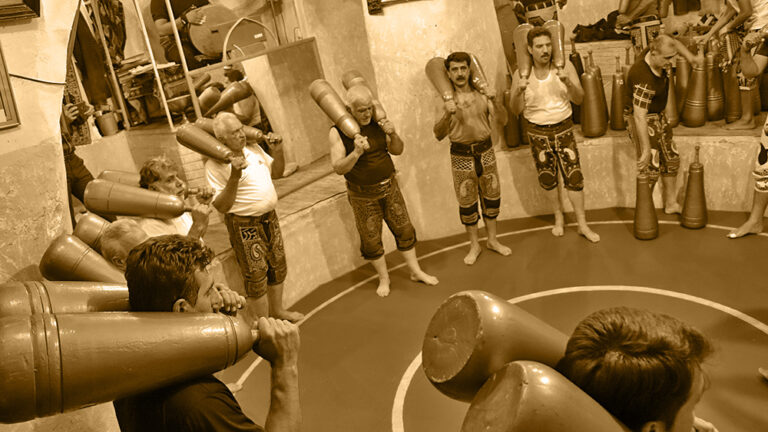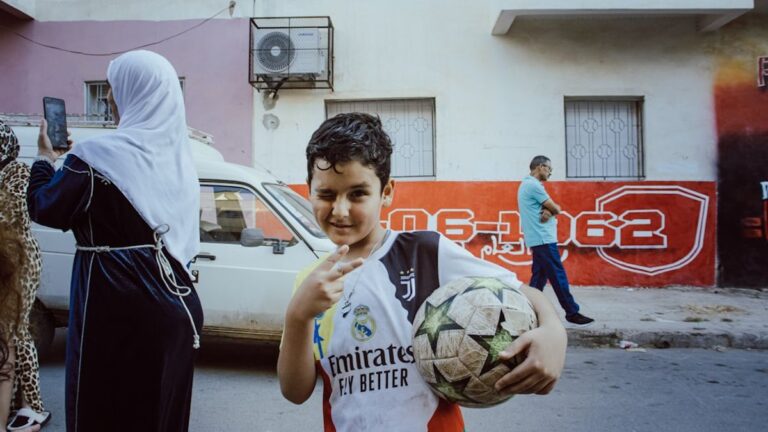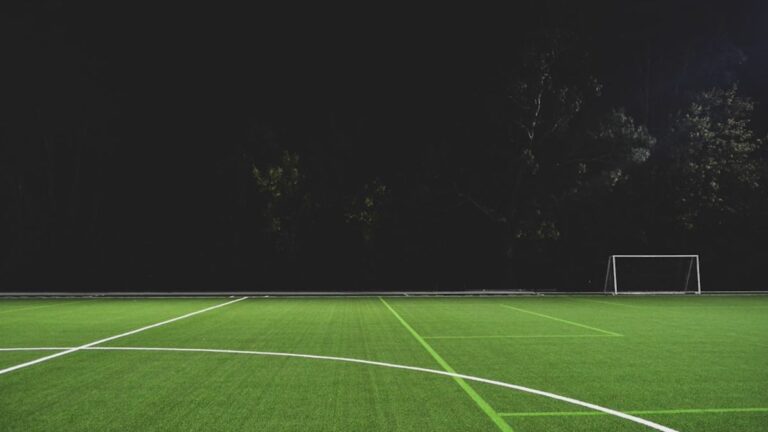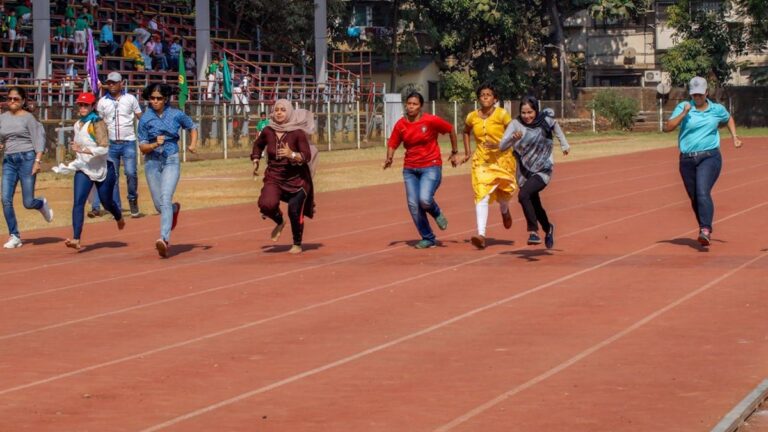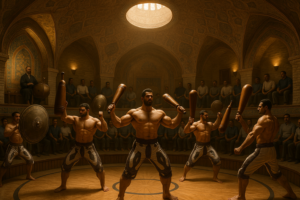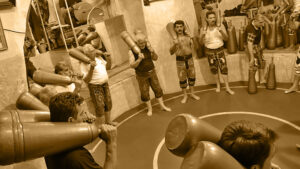practices and creates a unique environment for personal transformation.
The Role of the Morshed
The Morshed serves as the spiritual guide, musical director, and rhythmic coordinator of the Zurkhaneh session. This master practitioner must possess deep knowledge of Persian classical literature, traditional music, and the philosophical foundations of the practice.
Similar to how Iranian women athletes have broken barriers in modern sports, the Morshed breaks the barriers between physical and spiritual training, creating a unified experience that transcends ordinary exercise.
Traditional Instruments and Their Significance
The musical elements of Zurkhaneh practice involve specific instruments, each carrying symbolic and practical importance:
The zarb drum represents the heartbeat of the earth, while the zang bell symbolizes the call to spiritual awakening. Together, they create a soundscape that transcends ordinary consciousness and facilitates entry into a state of focused meditation.
The Physical Practice: Ancient Exercises for Modern Strength
The physical component of Zurkhaneh practice consists of a series of traditional exercises performed with specific implements, each designed to develop different aspects of strength, flexibility, and coordination. These exercises, known collectively as Varzesh-e Bastani (ancient sport), have been refined over centuries to provide comprehensive physical development.
Just as Iranian football’s rising stars combine traditional techniques with modern training methods, Zurkhaneh practitioners blend ancient wisdom with contemporary understanding of human physiology to achieve optimal results.
Primary Exercise Categories
Meel (Wooden Clubs): These weighted wooden implements, ranging from 2 to 40 kilograms, are swung in rhythmic patterns that develop shoulder strength, core stability, and cardiovascular endurance.
Kabbadeh (Steel Bow): This flexible steel implement is bent and manipulated in various patterns, primarily targeting the chest, shoulders, and arms.
Khanjar (Push-ups): Traditional Persian push-ups performed in the gaud, often synchronized with the rhythm of the music.
Modern Relevance and Benefits in 2025
In our increasingly digital and sedentary world, Zurkhaneh offers a compelling alternative to modern fitness approaches. Research conducted by sports scientists and wellness experts has identified numerous benefits that make this ancient practice particularly relevant for contemporary practitioners.
Physical Benefits
Functional Strength Development: Unlike isolated muscle training common in modern gyms, Zurkhaneh exercises develop functional strength through compound movements that engage multiple muscle groups simultaneously.
Cardiovascular Health: The rhythmic nature of the exercises, combined with their duration a
Zurkhaneh 2025: The Ultimate Ancient Persian House of Strength Revolutionizing Modern Fitness and Mental Wellness
Table of Contents
- The Historical Foundation of Zurkhaneh
- The Sacred Architecture
- The Ritual Elements
- The Physical Practice
- Modern Relevance and Benefits
- Conclusion
In an era where fitness trends come and go with alarming frequency, one ancient Persian tradition stands as an unwavering pillar of physical and spiritual development. Zurkhaneh, literally meaning “house of strength,” represents far more than a gymnasium or training facility—it embodies a complete philosophy of human development that has endured for over seven centuries.
The significance of Zurkhaneh extends beyond its historical roots, emerging as a powerful alternative to contemporary fitness culture. This comprehensive exploration reveals how this UNESCO-recognized intangible cultural heritage continues to transform lives, offering a unique pathway to strength that encompasses not just physical prowess, but mental resilience, ethical development, and spiritual awakening.
The Historical Foundation of Zurkhaneh: Seven Centuries of Unbroken Tradition
The origins of Zurkhaneh trace back approximately 700 years to the Persian Empire, founded by the legendary figure Mahmoud Marouf. This ancient practice emerged during a period when Persian culture was seeking to preserve its identity and values through physical and spiritual disciplines. The Pahlevani and Zoorkhaneh rituals, as they are formally known, represent one of the world’s oldest continuously practiced forms of strength training and martial arts.
“The zurkhaneh is not merely a place of physical exercise, but a sanctuary where the ancient Persian ideals of chivalry, honor, and spiritual development converge into a unified practice of human excellence.” – UNESCO Cultural Heritage Documentation
Historical records indicate that Zurkhaneh served multiple purposes throughout Persian history. During times of political oppression, these houses of strength became centers of resistance, where Persian identity and values were preserved and transmitted to future generations. The practice incorporated elements from various sources: ancient Persian warrior traditions, Islamic mysticism, Sufi philosophy, and pre-Islamic Iranian customs, creating a unique synthesis that has remained remarkably consistent across centuries.
The architectural design of traditional Zurkhaneh facilities reflects deep symbolic meaning. The octagonal pit, known as the gaud, represents the eight directions of the universe in Persian cosmology.
The Sacred Architecture: Understanding the Zurkhaneh Structure
The physical design of a Zurkhaneh is far from arbitrary—every element serves both practical and spiritual purposes. The traditional structure consists of several key components that work together to create an environment conducive to both physical training and spiritual development.
| Component | Physical Function | Symbolic Meaning |
|---|---|---|
| Gaud (Central Pit) | Exercise area for group activities | Earth, foundation of existence |
| Sardam (Elevated Platform) | Position for the Morshed (master) | Spiritual guidance and leadership |
| Domed Ceiling | Acoustic enhancement for music | Connection to the divine realm |
| Gallery Seating | Observation area for community | Collective witness to transformation |
The Sardam, an elevated platform where the Morshed sits, serves as the spiritual and rhythmic heart of the Zurkhaneh. From this position, the master recites poetry from classical Persian literature, particularly the works of Ferdowsi’s Shahnameh (Book of Kings), while maintaining the rhythm with traditional instruments.
The Ritual Elements: Music, Poetry, and Movement in Harmony
The practice of Zurkhaneh is distinguished by its integration of multiple artistic and physical elements into a cohesive ritual experience. This holistic approach sets it apart from conventional fitness

